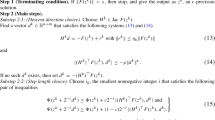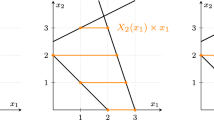Abstract
This paper is about games where the agents face constraints in the combined strategy space (unlike in standard games where the action sets are defined separately for each player) and about computational methods for solutions to such games. The motivation examples for such games include electricity generation problems with transmission capacity constraints, environmental management to control pollution and internet switching to comply to buffers of bounded capacity. In each such problem a regulator may aim at compliance to standards or quotas through taxes or charges. The relevant solution concept for these games has been known under several names like generalised Nash equilibrium, coupled constraint equilibrium and more. Existing numerical methods converging to such an equilibrium will be explained. Application examples of use of NIRA, which is a suite of Matlab routines that implement one of the methods, will be provided.
Similar content being viewed by others
References
Aubin J-P (1993) Optima and equilibria. Springer, Berlin Heidelberg New York
Debreu G (1952) A social equilibrium existence theorem. Proc Nat Acad Sci 38(10):886–893
Arrow KJ, Debreu G (1954) Existence of an equilibrium for a competitive economy. Econometrica 22:265–290
Başar T (1987) Relaxation techniques and asynchronous algorithms for online computation of non-cooperative equilibria. J Econ Dyn Control 11:531–549
Berridge S, Krawczyk J (1997) Relaxation algorithms in finding Nash equilibria. Economic Working Papers Archive. URL: http://econwpa.wustl.edu/eprints/comp/papers/9707/9707002.abs
Contreras J, Klusch M, Krawczyk JB (2004) Numerical solutions to Nash–Cournot Equilibria in Coupled Constraint Electricity Markets. [doi:10.1109/TPWRS.2003.820692 Copyright 2004 IEEE.] IEEE Trans Power Syst 19(1):195–206
Facchinei F, Pang JS (2003) Finite-dimensional variational inequalities and complementarity problems I and II. Springer, Berlin Heidelberg New York
Fudenberg D, Tirole J (1991) Game theory. MIT Press, Cambridge
Haurie A, Krawczyk JB (1997) Optimal charges on river effluent from lumped and distributed sources. Environ Model Assess 2(3):93–106
Haurie A, Krawczyk JB (2002) An introduction to dynamic games, internet textbook. URL: http://ecolu-info.unige.ch/~haurie/fame/textbook.pdf
Hobbs B, Pang J-S (2006) Nash-Cournot equilibria in electric power markets with piecewise linear demand functions and joint constraints. Operations Research (in press)
Harker PT (1991) Generalized Nash games and quasivariational inequalities. Eur J Oper Res 54:81–94
Ichiishi T (1983) Game theory for economic analysis. Academic Press, New York
Kesselman A, Leonardi S, Bonifaci V (2005) Game-theoretic analysis of internet switching with selfish users. In: Proceedings of the first international workshop on internet and network economics, WINE, Lectures Notes in Computer Science, Vol 3828, pp 236–245
Krawczyk JB (2005) Coupled constraint Nash equilibria in environmental games. Resour Energy Econ 27(2):157–181
Krawczyk JB, Uryasev S (2000) Relaxation Algorithms to find Nash equilibria with economic applications. Environ Model Assess 5:63–73
McKenzie LW (1959) On the existence of general equilibrium for a competitive market. Econometrica 27:54–71
Nikaido H, Isoda K (1955) Note on noncooperative convex games. Pac J Math 5(1):807–815
Nagurney A (1993) Network economics: a variational inequality approach. Kluwer, Boston
Nurminski EA (1982) Subgradient method for minimizing weakly convex functions and ε-subgradient methods of convex optimization. Progress in Nondifferentiable Optimization: Collaborative Proceedings CP-82-S8, Laxenburg, Austria, International Institute for Applied Systems Analysis, pp 97–123
Pang JS, Fukushima M (2005) Quasi-variational inequalities, generalized Nash equilibria and multi-leader-follower games. Comput Manage Sci 1:21–56
Randall A (1987) Resource economics. Wiley, New York
Robinson SM (1993) Shadow prices for measures of effectiveness. II. General model. Oper Res 41(3):536–548
Rosen JB (1965) Existence and uniqueness of equilibrium points for concave n-person games. Econometrica 33(3):520–534
Tidball M, Zaccour G (2005) An environmental game with coulpling constraints. Environ Model Assess 10:153–158
Shor NZ (1985) Minimization methods for non-differentiable functions. Springer, Berlin Heidelberg New York
Uryasev S, Rubinstein RY (1994) On relaxation algorithms in computation of noncooperative equilibria. IEEE Trans Autom Control 39(6):1263–1267
Author information
Authors and Affiliations
Corresponding author
Rights and permissions
About this article
Cite this article
Krawczyk, J. Numerical solutions to coupled-constraint (or generalised Nash) equilibrium problems. CMS 4, 183–204 (2007). https://doi.org/10.1007/s10287-006-0033-9
Published:
Issue Date:
DOI: https://doi.org/10.1007/s10287-006-0033-9
Keywords
- Computational economics
- Compliance problems
- Coupled constraint games
- Eeneralised Nash Equilibrium
- Nikado–Isoda function
- Relaxation algorithm (NIRA)
- Quasi-variational inequalities




